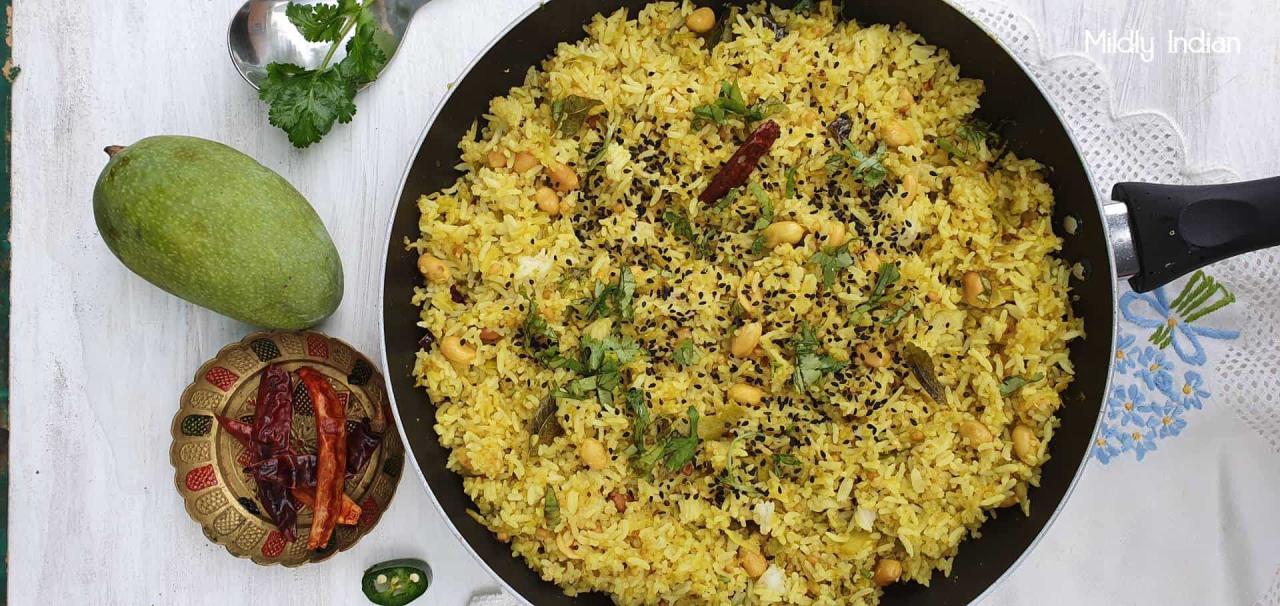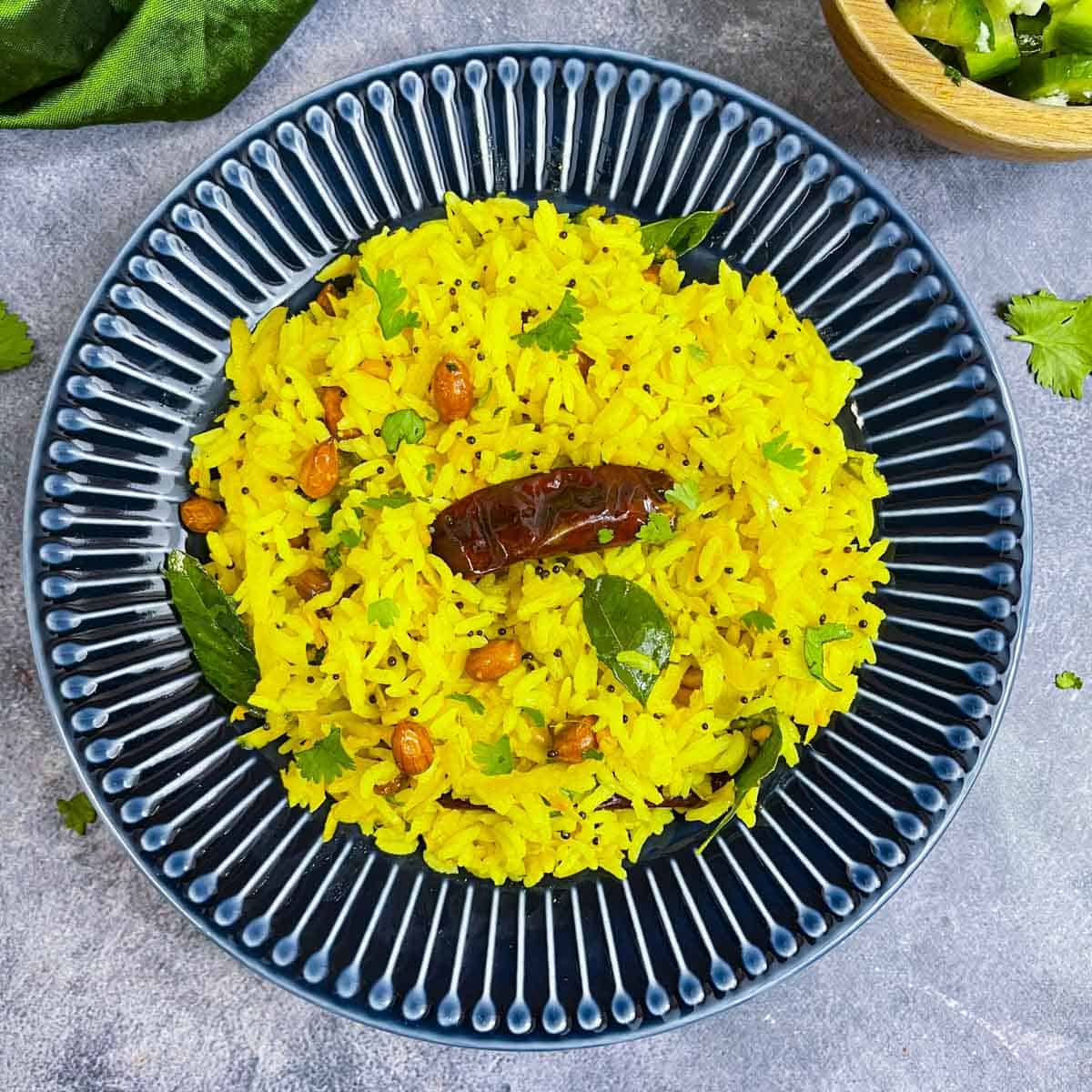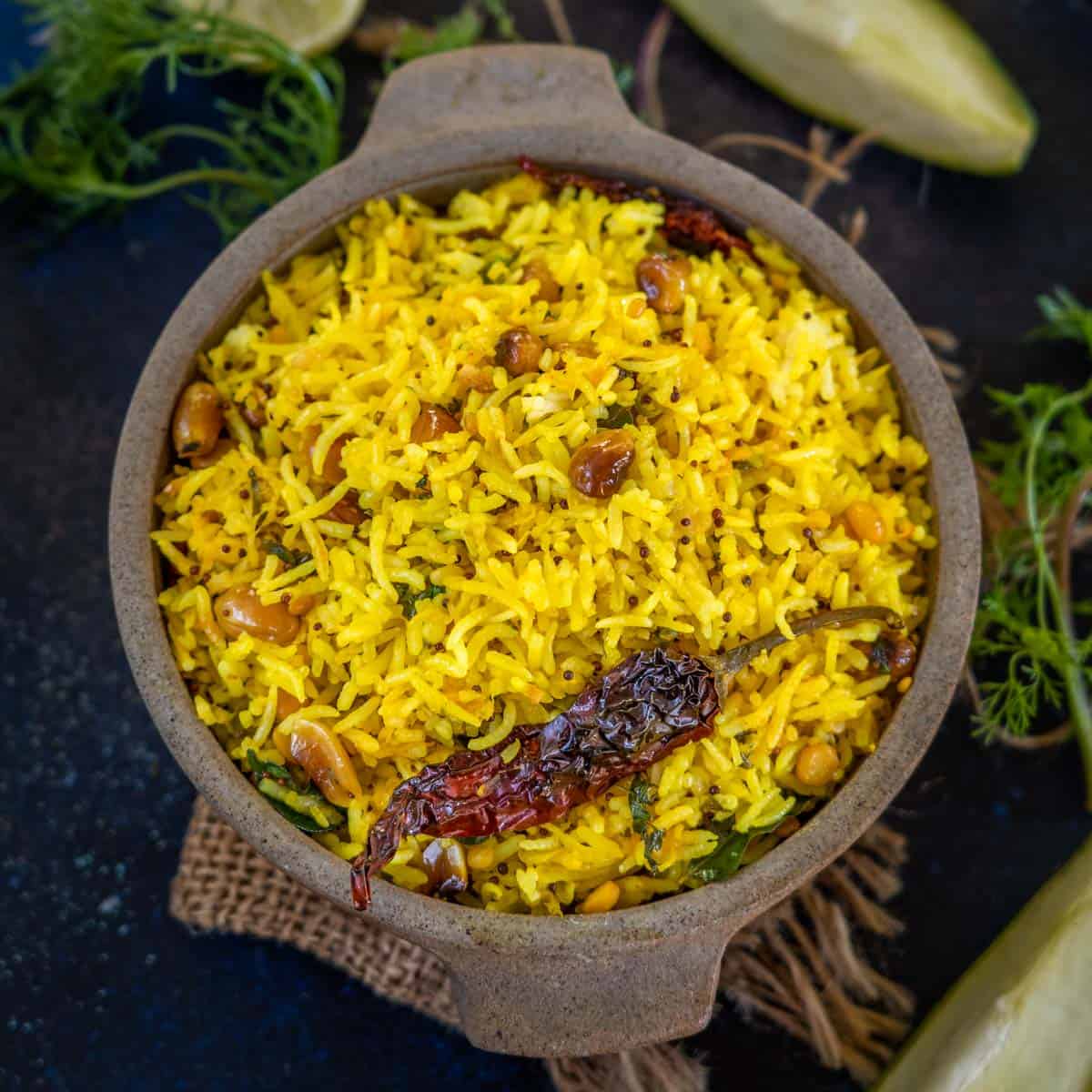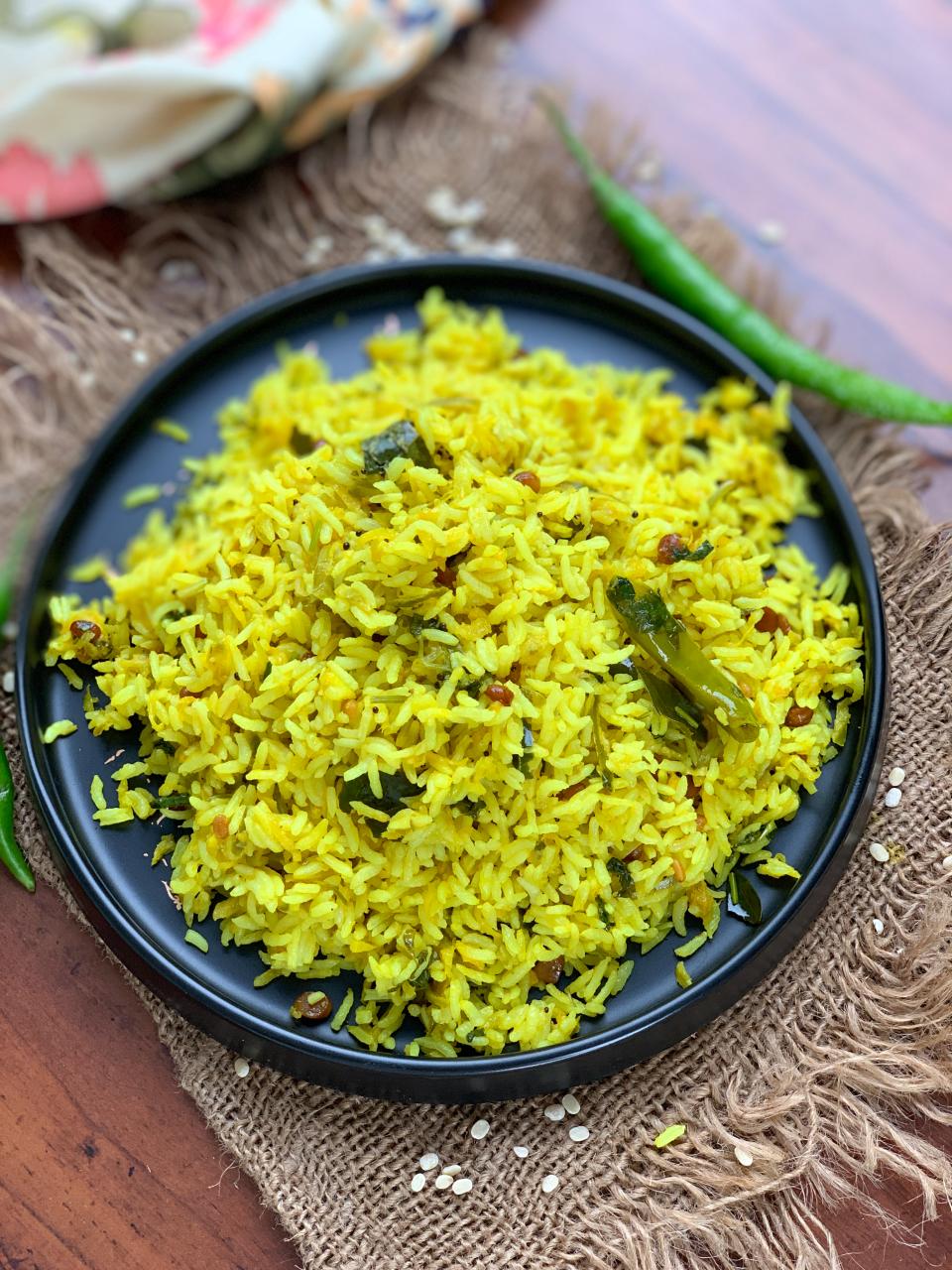As summer unfurls its vibrant canvas across the Indian subcontinent, a culinary delight that captures the essence of this warm season is the Mavinakayi Chitranna, also known as Raw Mango Rice. This recipe finds its roots intertwined with the fabric of South Indian cuisine, where the tangy zest of unripe mangoes blends with the subtle heat of green chilies and the earthy touch of spices to create a dish that is both refreshing and satiating.
Mavinakayi Chitranna charms the palate with its medley of flavors; each grain of rice carries the tender sourness of raw mango, the tempering bestows a crackling splendor, and the finish of fresh coriander leaves adds a verdant flourish. It’s a dance of ingredients that hold the spirit of simplicity and the promise of an utterly satisfying meal.
Mavinakayi Chitranna Raw Mango Rice Recipe


Mavinakayi Chitranna Raw Mango Rice
Ingredients
- 1 cup sona masoori rice rinsed in cool water, drained, and cooked according to the package instructions
- 1 tablespoon plus 1/2 teaspoon vegetable or corn oil divided
- 11/2 teaspoons fenugreek seeds
- 11/2 teaspoons white sesame seeds
- 4 dried Guntur chiles
- 1/2 teaspoon asafoetida
- 1/4 cup shredded fresh coconut or frozen, thawed to room temperature
- 1/2 teaspoon mustard seeds
- 1/2 teaspoon husked whole black lentils
- 1/2 teaspoon Bengal gram
- 10 peanuts
- 1/2 cup shredded raw mango
- 1/2 cup raw mango cubes
- 1/2 teaspoon ground turmeric
- 2 teaspoons salt
- 1 teaspoon powdered jaggery
Instructions
- Spread the cooked rice on a plate and fluff it with a fork. Set aside.
- In a large skillet over medium heat, heat 1⁄2 teaspoon of the oil.
- Add the fenugreek seeds, sesame seeds, Guntur chiles, and asafoetida. Dry-roast the spices for 1 minute. Turn off the heat, and stir in the coconut. Let cool.
- Transfer the spice mixture to a spice grinder or clean coffee grinder and grind into a coarse powder. Set aside.
- Return the skillet to medium heat and heat the remaining 1 tablespoon of oil.
- Add the mustard seeds, black lentils, Bengal gram, and peanuts. Cook until the mustard seeds begin to sputter, about 1 minute.
- Add the shredded and the cubed mango and turmeric. Cook for 7 minutes, stirring frequently, until the mango no longer smells raw. Stir in the salt and jaggery and cook for 2 minutes more. Turn off the heat.
- Add the rice to the chitranna mixture in the skillet and gently stir to combine.
Notes
if you prefer.
Cooking Tips about Mavinakayi Chitranna Raw Mango Rice

- Rice Selection: Short-grained rice like Sona Masoori is traditionally favored for its non-sticky texture after cooking. However, Basmati rice can also be used for an aromatic alternative. The cooked rice should be fluffy and separate to ensure it evenly absorbs the flavors.
- Preparing the Mango: Choose green, unripe mangoes that are firm. They should be peeled and grated or finely chopped. The sourness of the mango invigorates the palate and balances the spice elements in the dish.
- Cooking the Rice: It’s important that the rice is not overcooked. Ideally, it should be prepared with a slightly reduced water ratio than usual so that the grains remain distinctly separate once cooled. This makes the mixing process easier.
- Tempering (Tadka): The tempering is vital in infusing flavor into the oil. Mustard seeds, chana dal, urad dal, dried red chilis, asafoetida (hing), curry leaves, and sometimes peanuts or cashews are tempered until golden brown, releasing their flavors and fragrances.
- Turmeric Powder: Adding turmeric powder early in the tempering gives the rice its characteristic yellow color. Ensure it’s mixed well so the color distributes evenly.
- Balancing Flavors: Ensure there is a perfect balance between the tartness of the mango, the heat from the green chilies, and the bitterness of the mustard seeds. Adjust the quantities according to taste preferences.
- Final Mixing: Allow the rice to cool to room temperature before adding the tempering and grated mango. If mixed while hot, the rice grains may break. Use a wide pan or bowl for easy mixing.
- Resting Time: After preparing the Mavinakayi Chitranna, let it sit for a short period to allow the flavors to meld. This rest time deepens the tanginess of the mango and enhances the overall taste.
- Garnish: Garnish with fresh coriander leaves and additional grated mango, if desired. This adds a fresh element and a burst of color to the dish.
- Serving Suggestions: Serve Mavinakayi Chitranna with a dollop of yogurt or raita on the side to ease the tanginess and provide a creamy contrast.
- Leftovers: Store any leftovers in the refrigerator and enjoy as a cold salad the next day. The flavors tend to intensify, offering a differently delightful experience.
Serving suggestions about Mavinakayi Chitranna Raw Mango Rice

- Yogurt or Raita: The sourness and spiciness of the raw mango rice can be beautifully balanced with a side of cooling plain yogurt or a cucumber raita.
- Papadams: These crispy lentil wafers can be fried or roasted and offer a delightfully crunchy contrast to the soft grains of the mango-infused rice.
- Fried Peanuts or Cashews: Adding fried peanuts or cashews provides an additional layer of crunch and rich nutty flavor that complements the tartness of the mango.
- Coconut Chutney: A side of mild coconut chutney pairs wonderfully well, adding a creamy texture and subtle sweetness that round out the sharpness of the dish.
- Pickle: An accompaniment of spicy Indian pickle can provide an intense burst of flavor, making each bite more dynamic.
- Simple Vegetable Salad: Serve a salad with raw vegetables like radishes, carrots, and cucumber. A light dressing of lemon juice can tie it nicely to the overarching theme of citrus.
- Boondi: These tiny gram flour balls soaked in spiced yogurt can become a juicy garnish that introduces a new texture to relish alongside the Mavinakayi Chitranna.
- Plain Dry Curry or Stir Fry: A simple stir fry of vegetables or a dry curry such as potato roast would complement well without overpowering the main dish’s flavors.
- Kerai Kootu (Spinach Lentil stew): This mild stew made with spinach and lentils gives a comforting taste and nutritional balance to the meal.
- Vada (Lentil fritters): A savory fried snack like vada made from ground lentils and spices act as a perfect side serving for extra substance.
- Buttermilk or Lassi: A glass of spiced buttermilk or sweet lassi can soothe the palette, especially if your version of Mavinakayi Chitranna packs a punch.
Top 5 FAQs about Mavinakayi Chitranna Raw Mango Rice

- What type of rice is best for Mavinakayi Chitranna? Short-grained rice like Sona Masoori is traditionally preferred due to its non-sticky texture after cooking. Basmati rice can also be used as an aromatic alternative. The key is that the cooked rice should be fluffy and the grains should be separate to absorb the flavors well.
- How do you select and prepare the mangoes for this dish? Choose firm, green, unripe mangoes for their tanginess. They should be peeled and either grated or finely chopped to ensure the sourness is distributed throughout the dish.
- Can lemon juice be used as a substitute for raw mango in Mavinakayi Chitranna? While lemon juice can offer some tanginess, it does not replicate the distinctive tart flavor and texture that raw mango provides. It’s best to use raw mango to achieve the authentic taste of the dish.
- What is the significance of the tempering (tadka) in Mavinakayi Chitranna? The tempering process is crucial for adding flavor. Mustard seeds, chana dal, urad dal, dried red chilis, asafoetida (hing), curry leaves, and sometimes nuts are tempered in oil until golden brown to release aroma and add depth to the dish.
- How should leftovers of Mavinakayi Chitranna be stored and eaten? Leftovers can be stored in the refrigerator and can be enjoyed cold as a salad the next day, as the flavors will intensify. Ensure that the dish is stored in an airtight container to maintain freshness.
Mavinakayi Chitranna, also known as Raw Mango Rice, is a traditional South Indian dish popular especially in the state of Karnataka. It is a flavorful and tangy dish made by mixing cooked rice with a spiced raw mango paste. The dish is particularly enjoyed during the mango season, when raw mangoes are plentiful.

Leave a Reply